How to Write an Outline for Synthesis Essay, Step by Step
You want to know how to build an outline for synthesis essay. Here’s how it works:
Outlining is the initial step to crafting a high-quality, A-worthy paper. If you miss this element, you risk losing focus and flow. More than that, you can’t generate an argumentative, logical, and close-knit essay without it.
This article won’t let it happen.
Keep reading to reveal actionable tips on outline writing. You’ll know what to include in each paragraph and how to structure it for better results.
Bonus for the most avid readers: A free PDF template for outlining synthesis essays.

What Is a Synthesis Essay Outline?
| A is a comprehensive plan for your paper. It shows off the info on what you’ll write in every section. |
Think of it as a table of contents you’ll expand in your work. Outlines serve to organize essays and regulate their elements for a stellar presentation.
Why design an outline for synthesis essays?
- Systemize the sources and decide on the claims to use in every paragraph.
- Organize the claims and prescribe evidence for each.
- Focus on the writing process, preventing the writer’s block. (It’s when you stare at the screen and don’t know what to write next.)
- Ensure you’ve included all the info and introduced it logically.
- Structure a paper in advance to save time and write faster.
Whether you work on an AP lang essay or craft an expository essay in college, outlining is a must. It organizes arguments and evidence so you don’t forget anything while writing.
Before outlining
Synthesis essays are about analyzing several sources to establish an original thesis. So, before you sit and craft an outline, do research and decide on the sources you’ll synthesize.
- Focus on those related to your topic.
- Consider solid resources: latest studies, research papers, books , academic journals, etc.
- Analyze each to derive core points.
You’ll apply the resources to support your thesis throughout an essay. Ensure they have solid evidence so you can incorporate it into your paper. Decide on the facts, quotes, and examples to cover in every paragraph as proof of your claim.
How to Make an Outline for the Synthesis Essay
Below is the template you can try, with an introduction, body, and conclusion as main parts of the outline used for a synthesis essay (1).
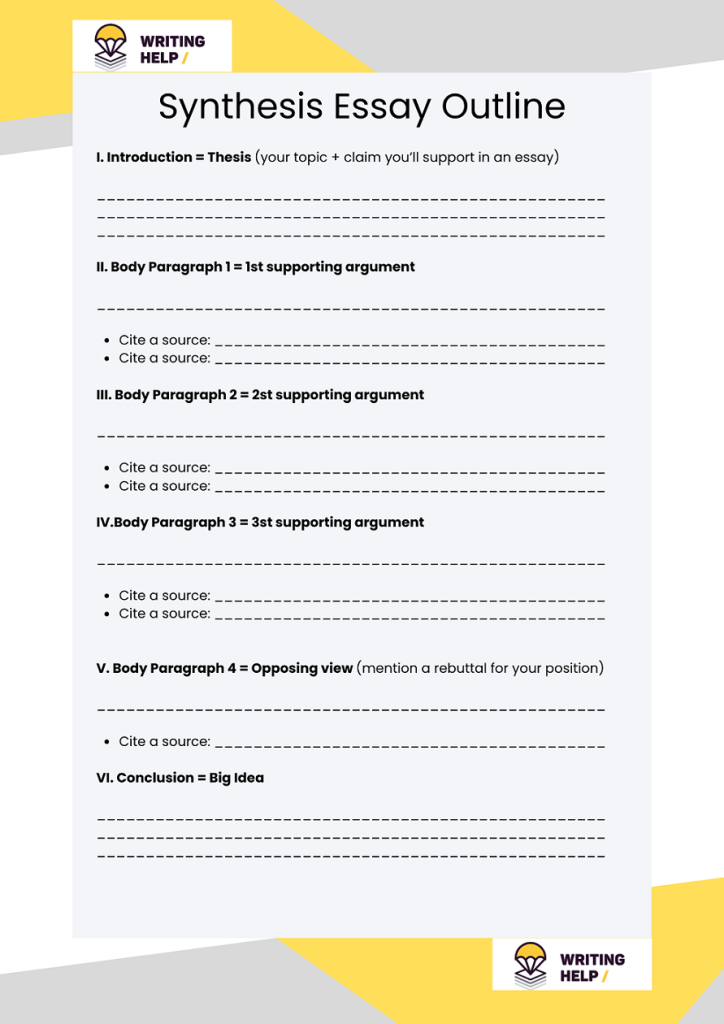
Download a free PDF version here
And now, to the details to include in every paragraph.
1. State a Thesis
Synthesis essays aren’t about summarizing. You need to analyze at least three — and generate a new, your own thesis based on them. The synthesized sources will be the evidence to prove your thesis. They will support the arguments you’ll use in favor of your claim.
With that in mind, state a thesis for your essay in the outline.
Once you have it, you’ll know how to underline the arguments and evidence in paragraphs.
Check a thesis example on “Is the spread of fake news a problem?”
And that’s a thesis example for an essay on “The American Dream: Is it still achievable?”
With a ready thesis statement, you can deal with the outline for a synthesis essay.
2. S tructure an Introductory Paragraph
The must-have ingredients of an essay introduction are:
Think of a compelling sentence to start your essay. It’s a hook to grab the reader’s attention and motivate them to keep reading. Use a question, a quote, a fact, etc.
After that, introduce the context. It’s background information on your topic where you mention the sources you’ll use.
The final 1-2 sentences go to a thesis. State your position and provide the arguments that show why you have it. (You’ll expand those arguments in the essay body.)
3. Organize Body Paragraphs
The number of paragraphs in your essay body depends on how many sources you’ll synthesize. Formal tips for synthesis writing prescribe at least three resources, which means you’ll include three body paragraphs in your paper.
Each one needs the following info to cover:
- A topic sentence explaining your argument (Think of a new claim for each paragraph.)
- Evidence from the source that supports your topic sentence
- Elaboration that clarifies how that evidence supports your claim
If you have several sources supporting your argument, you can mention them all in a paragraph.
In a synthesis essay outline, note a claim and evidence for every paragraph.
4. Mention a Rebuttal
One paragraph of your synthesis essay should cover an opposing view that challenges your position. Outline it as follows:
- State an alternative point to your argument; provide evidence to back up that view.
- Provide your counterargument to that view. Why is it not as valid as yours? Highlight your position on the topic.
- Share evidence to prove the opposing point is wrong.
Write about the rebuttal in the fourth body paragraph. If you follow a standard 5-paragraph structure, use two sections for your claims and one — for a counterargument to your claims. The other two remain for an intro and a conclusion.
5. Write a Conclusion
Summarize the points and restate your thesis to maintain your position. Finish your essay with a recommendation or a call to action for readers.
This final statement is a so-called big idea behind your paper. Leave readers with the food for thought. You can encourage them to continue investigating the topic to learn more and build their own attitude.
Outline for a Synthesis Essay: Example
This sample is here to give you an idea of what to write in every section. Please don’t copy it for your papers. It’s a sample for informative purposes.
Let’s say you write a synthesis essay, “Is the spread of fake news a problem?”
Here’s what the outline might be:
I used some writing tools to assist me with this outline creation. You can do the same, but ensure to adjust and polish the outline to your position and needs.
Synthesis Essay Outline: Write Yours!
Now you know the components to cover in your outline for a synthesis essay. It’s time to practice and write one for your future paper!
- Consider the provided template.
- Use the given sample for inspiration.
- Follow the structure and ensure to mention all the details.
- Organize your arguments and evidence; oppose a counterargument.
- Think of a memorable conclusion for readers.
Your outline is a plan. Once you have it, you’ll write an A-worthy synthesis essay faster, whether AP lang or general.
References:
- https://dcdc.coe.hawaii.edu/ltec/612/wp-content/uploads/2015/02/Synthesis-Essay-Instructions-and-Worksheets.pdf
- Essay samples
- Essay writing
- Writing tips
Recent Posts
- Writing the “Why Should Abortion Be Made Legal” Essay: Sample and Tips
- 3 Examples of Enduring Issue Essays to Write Yours Like a Pro
- Writing Essay on Friendship: 3 Samples to Get Inspired
- How to Structure a Leadership Essay (Samples to Consider)
- What Is Nursing Essay, and How to Write It Like a Pro

Synthesis Worksheets
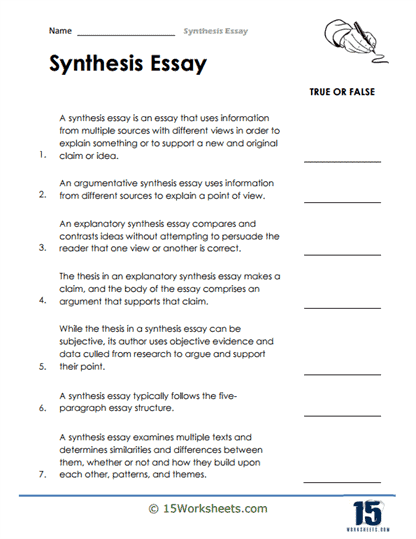
True Or False
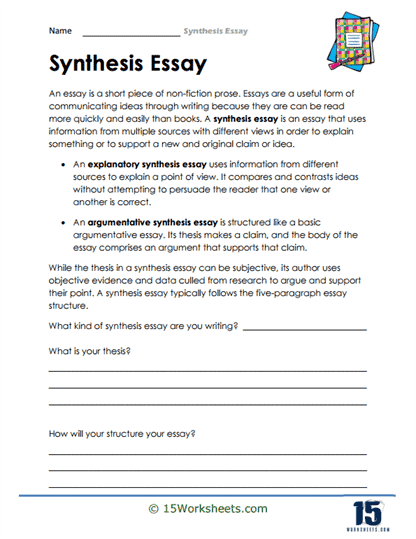
Explanatory And Argumentative
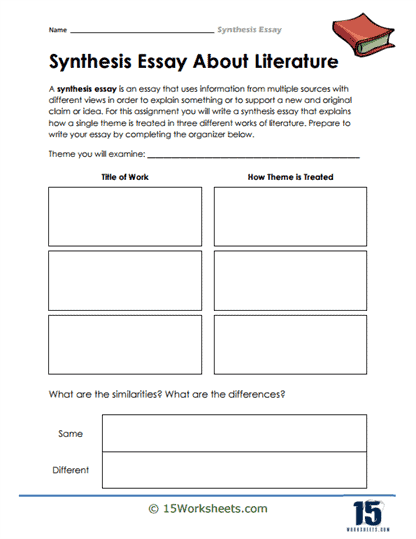
Same And Different
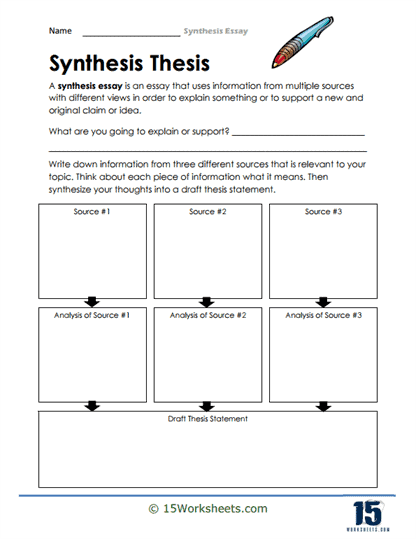
Multiple Sources
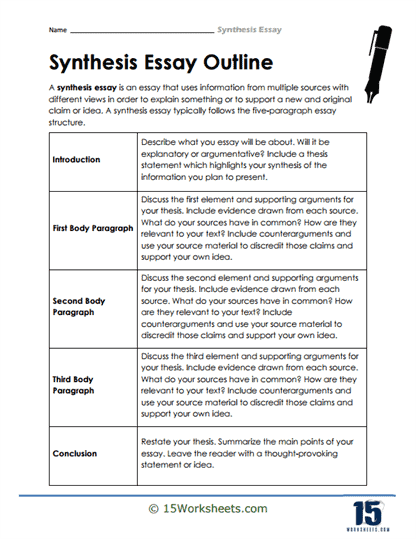
Five-Paragraph Structure
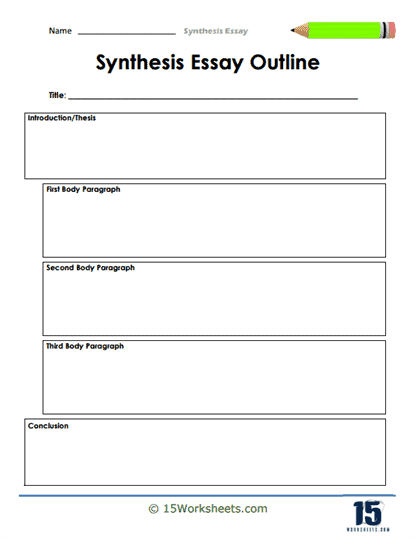
A Visual Framework
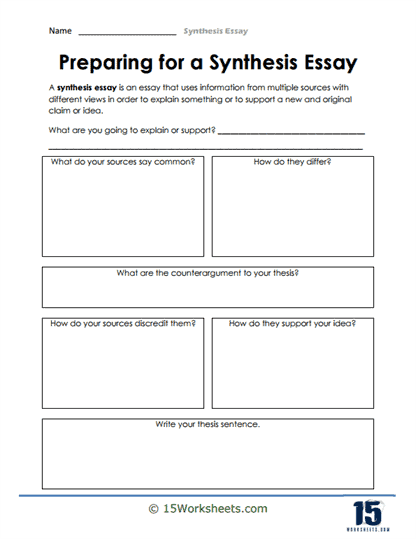
Preliminary Steps
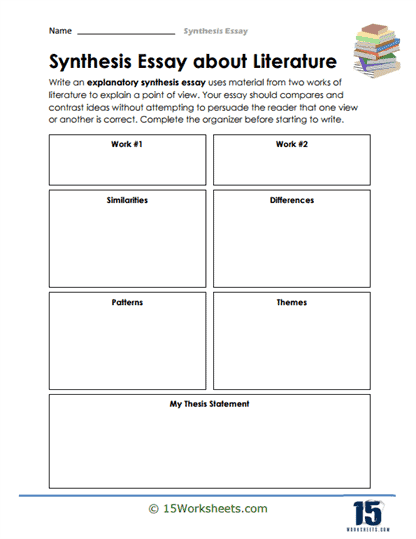
Explaining POVs
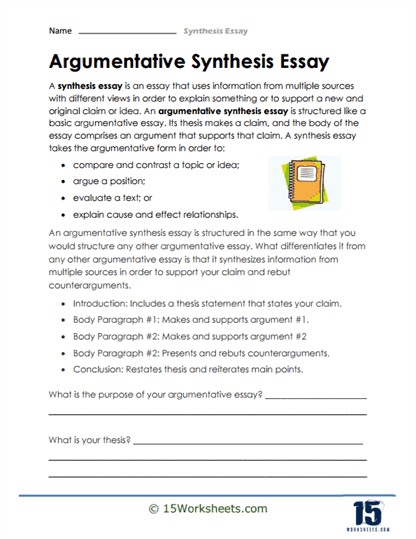
Persuasive Arguments
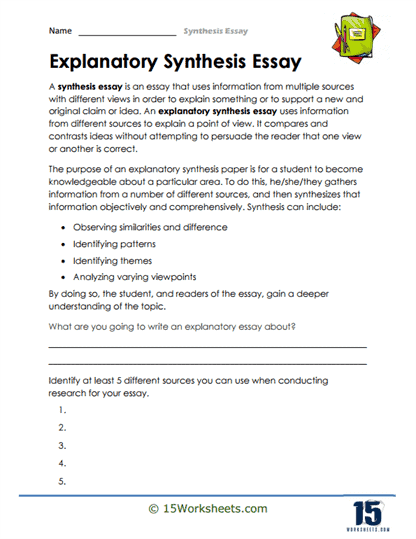
Explaining A Topic
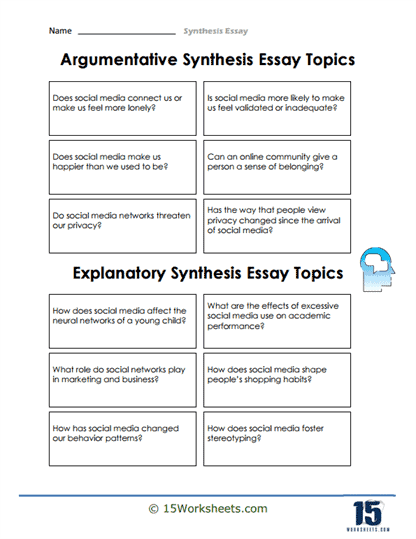
An Array Of Topics
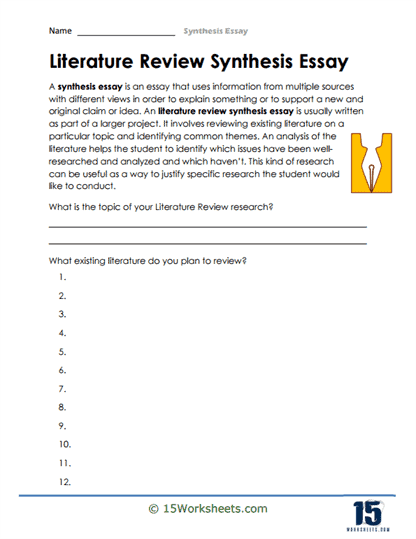
Literature Review
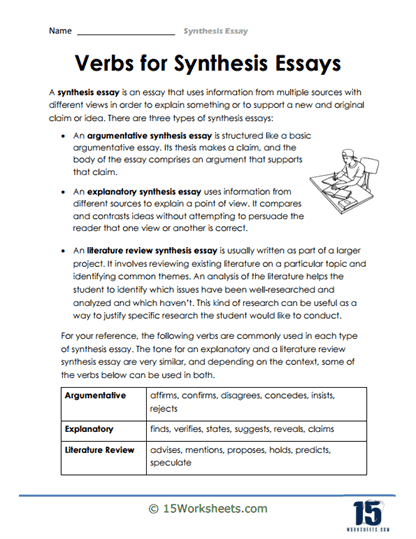
Commonly Used Verbs
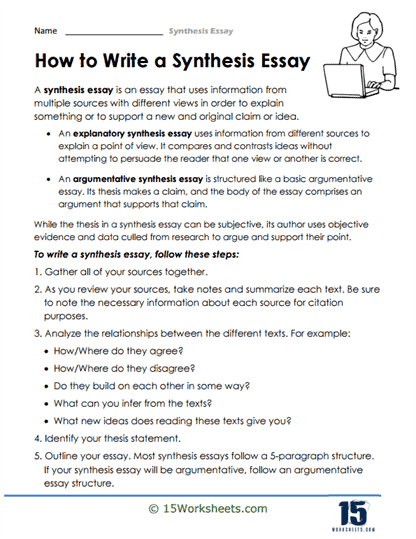
Step-by-Step Instructions
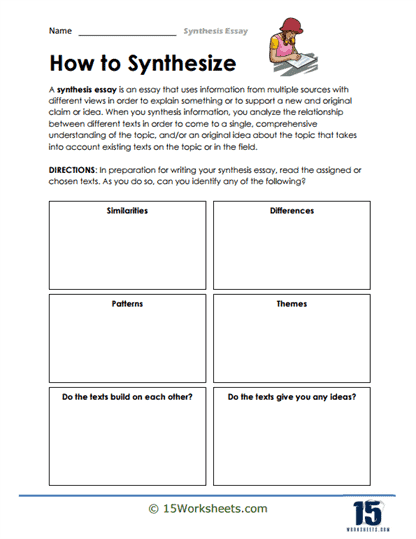
How To Synthesize
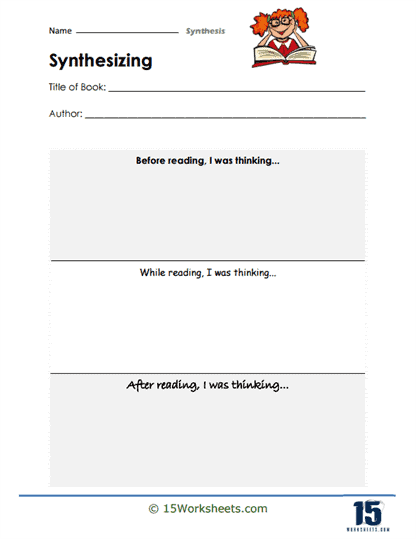
Before, While, After
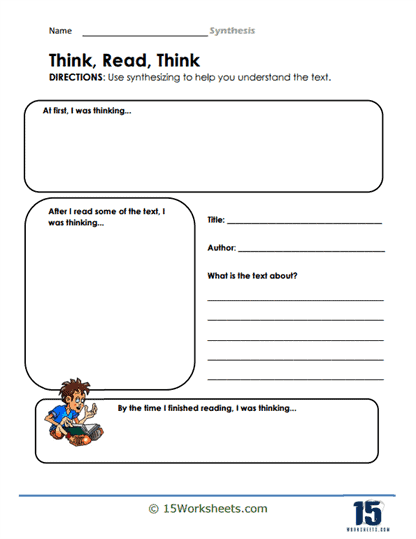
Think, Read, Think
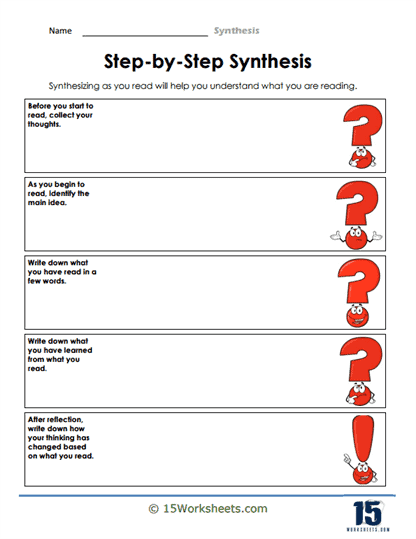
As You Read
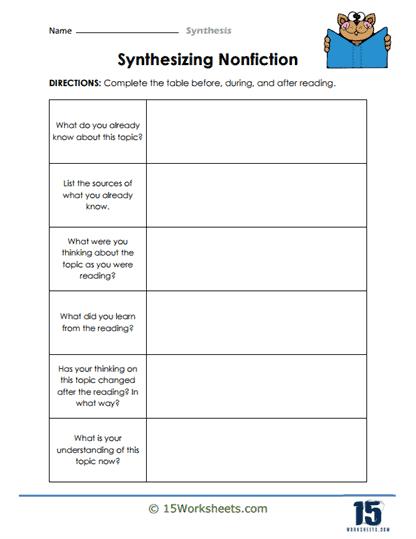
Nonfiction Texts
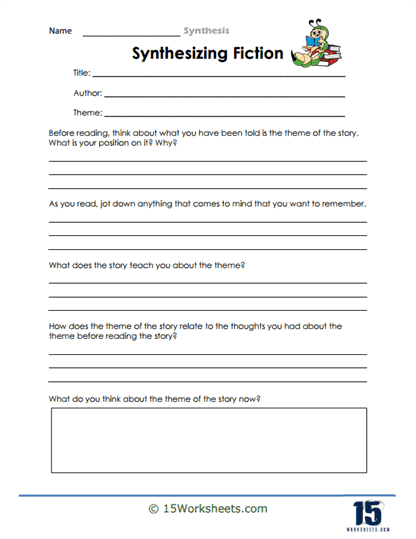
Studying Fiction
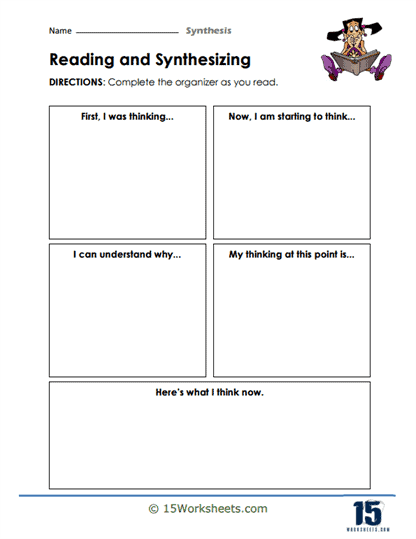
Beginning To Now
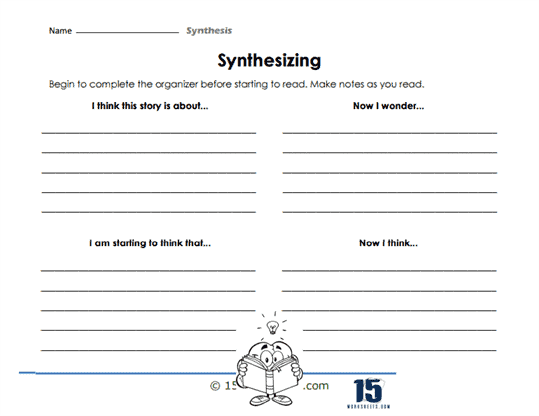
Making Notes
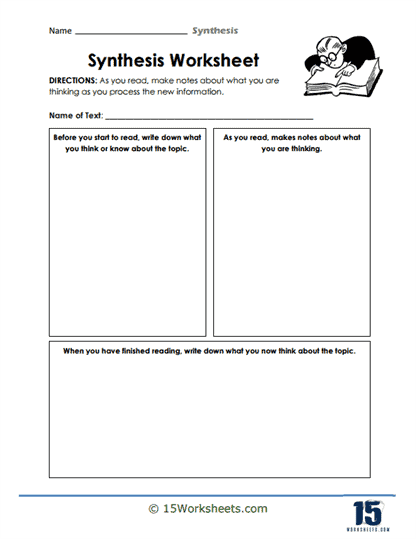
Processing New Info
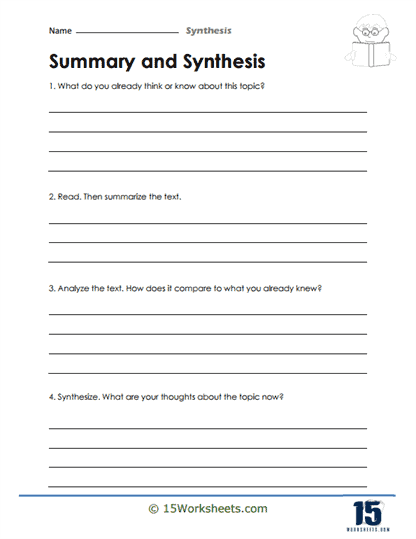
Summarize And Analyze
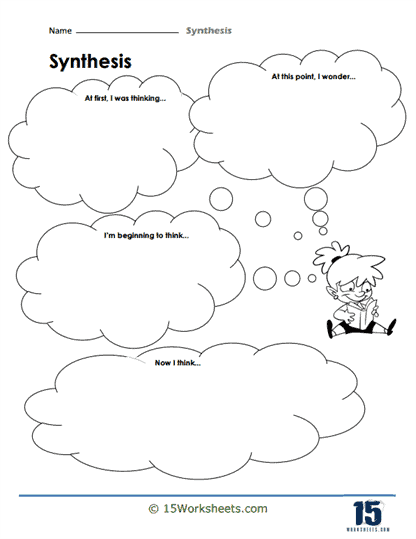
Thought Bubbles
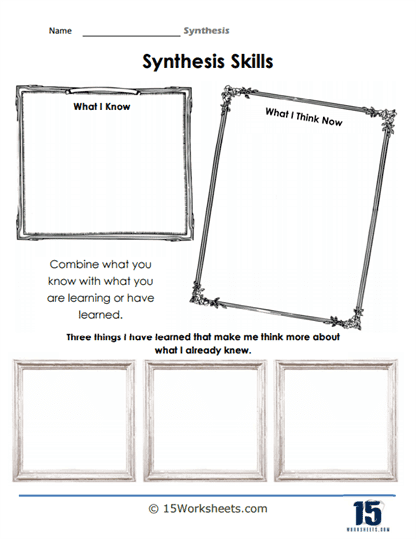

Knowing And Thinking
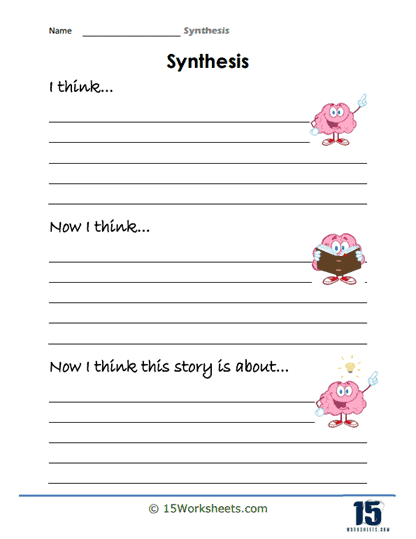
Articulate Your Thoughts
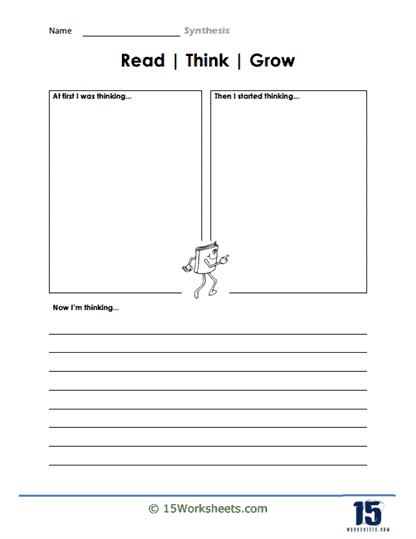
First, Then, Now
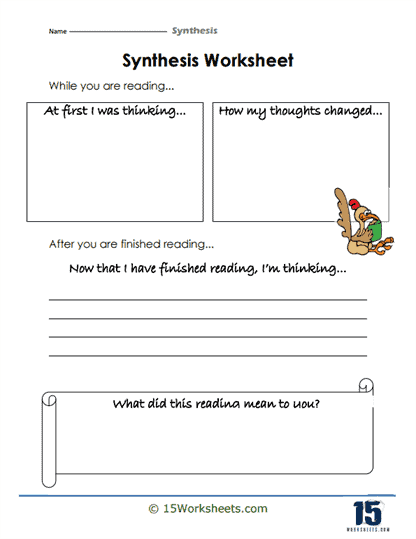
What It Means To You
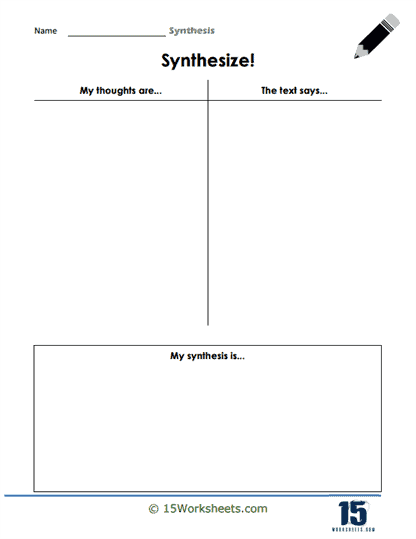
Compare And Combine
All about these 15 worksheets.
This series of 15 worksheets offers a comprehensive and engaging resource designed to help students master the art of crafting well-structured and persuasive synthesis essays. These meticulously designed worksheets provide a step-by-step approach to guide students in analyzing multiple perspectives, synthesizing information, and developing compelling arguments.
The writing prompts empower students to become critical thinkers, effective researchers, and skilled communicators. Through a series of thought-provoking exercises, students will learn to examine complex issues, integrate diverse sources, and present cohesive arguments that showcase their ability to understand, analyze, and synthesize information. Through these worksheets, students will:
- Analyze multiple sources, identify common themes or arguments, and integrate them into a coherent and persuasive essay;
- Assess the credibility, reliability, and relevance of sources, helping them make informed decisions about which sources to include in their synthesis essay;
- Identify patterns, connections, and discrepancies, helping them form a comprehensive understanding of the topic;
- Be guided with organizing their essay’s structure;
- And refine their ability to present their ideas in a coherent and compelling manner.
This series equips students with the skills necessary to excel in synthesizing information and presenting complex arguments. By mastering the art of synthesis essays, students will enhance their critical thinking abilities, research proficiency, and persuasive writing skills.
Whether used in English classrooms, advanced writing courses, or as part of college preparatory programs, these Synthesis worksheets provide an invaluable resource for students to develop their analytical thinking, research skills, and written expression.
What Is Synthesis In Writing?
Synthesis is commonly used in formal English academic writing. It is a written argument that utilizes different sources to support a thesis (theory or statement put forward in academic circles to be proved through scientific evidence and analysis of published works). Within the educational domain, a synthesis usually takes the form of an essay, and is known as a “synthesis essay.”
Usage of a Synthesis
While a synthesis is primarily used in academic writing, it has other applications too. Following are some common examples of using a synthesis.
Analysis Papers
Such documents are used to examine different theories that might be related to one another. For instance, an analysis paper might compare different theories of evolution. To do that, the author can make use of a synthesis essay to build their argument.
Argument Papers
Argument papers are used to make a comparison of divergent views, support a coherent claim, etc. For example, an author may write an argument paper on the topic “Is Turnitin an Abuse of Students’ Rights?” One argument could be that the online plagiarism detection service steals students’ work. On the other side, there’s the claim that students willfully give the permission to have their work archived before using the tool. Here again, a synthesis essay can help build the argument by analyzing both claims from a neutral standpoint.
Research Papers
To create a research paper of high value, you need to incorporate many reliable and accurate sources. For instance, if you’re writing on the social and economic effects of some proposed legislation, you can use a synthesis essay to evaluate multiple sources of published works and build your argument for or against the potential regulation.
Business Reports
Business reports are used to assess contrasting ideas. Authors of such documents try to find ways of blending different concepts together through their analysis.
Tips for Writing a High-Quality Synthesis Essay
Below are some tips that teachers can share with their students to help them write an effective synthesis essay:
- Define your purpose and main idea. This is what your thesis will be based on and the synthesis essay should spell that out clearly.
- Pick the sources you want to use after verifying their authenticity and reliability. Familiarize yourself with them so that you’re well versed to discuss them in connection to your thesis. Simply citing sources without a proper evaluation would weaken your thesis. Moreover, without a proper analysis of previously published works, the audience is likely to misinterpret the information.
- Prepare an organizational plan. Try to find more than a single source for each of the arguments that you plan to make in your thesis. Multiple sources will automatically improve your credibility and increase the weight of your argument. Pay special attention to how various sources might agree or disagree with each other. It’s up to you to carefully evaluate which source makes a more compelling argument and which one has better credibility.
- Make sure to document every source. Note down the page number and author. Also, don’t forget to list the source in the “Cited Sources” or “References” section. This is important because you don’t want anyone to think that you’ve plagiarized the content from somewhere. In fact, proper citation of every source is necessary if you summarize, quote, or paraphrase a previously published piece of work by another writer.
Synthesis Essay Materials
The two synthesis essay questions below are examples of the question type that has been one of the three free-response questions on the AP English Language and Composition Exam as of the May 2007 exam. The synthesis question asks students to synthesize information from a variety of sources to inform their own discussion of a topic. Students are given a 15-minute reading period to accommodate the additional reading required for the question.
Below is a sample synthesis essay question, sample scoring guidelines, comments from the Chief Reader about the sample student essays, seven sample student responses, and scoring commentary for each sample.
Approximately 300 AP English Language and Composition students from eight schools in New York, Maine, Texas, Tennessee, Washington, Florida, and New Mexico wrote responses to this synthesis topic. Students from these schools were given a 15-minute reading period followed by a 40-minute writing period in which to complete the sample synthesis assignment.
- AP English Language and Composition Synthesis Essay #1 (.pdf/84KB)
- Sample Scoring Guidelines (.pdf/43KB)
- Comments from the Chief Reader (.pdf/47KB)
- Sample Student Responses (.pdf/3.65MB)
- Scoring Commentary (.pdf/50KB)
An additional sample synthesis essay question is provided here.
- AP English Language and Composition Synthesis Essay #2 (.pdf/338KB)
Have a language expert improve your writing
Run a free plagiarism check in 10 minutes, generate accurate citations for free.
- Knowledge Base
- Working with sources
- Synthesizing Sources | Examples & Synthesis Matrix
Synthesizing Sources | Examples & Synthesis Matrix
Published on July 4, 2022 by Eoghan Ryan . Revised on May 31, 2023.
Synthesizing sources involves combining the work of other scholars to provide new insights. It’s a way of integrating sources that helps situate your work in relation to existing research.
Synthesizing sources involves more than just summarizing . You must emphasize how each source contributes to current debates, highlighting points of (dis)agreement and putting the sources in conversation with each other.
You might synthesize sources in your literature review to give an overview of the field or throughout your research paper when you want to position your work in relation to existing research.
Table of contents
Example of synthesizing sources, how to synthesize sources, synthesis matrix, other interesting articles, frequently asked questions about synthesizing sources.
Let’s take a look at an example where sources are not properly synthesized, and then see what can be done to improve it.
This paragraph provides no context for the information and does not explain the relationships between the sources described. It also doesn’t analyze the sources or consider gaps in existing research.
Research on the barriers to second language acquisition has primarily focused on age-related difficulties. Building on Lenneberg’s (1967) theory of a critical period of language acquisition, Johnson and Newport (1988) tested Lenneberg’s idea in the context of second language acquisition. Their research seemed to confirm that young learners acquire a second language more easily than older learners. Recent research has considered other potential barriers to language acquisition. Schepens, van Hout, and van der Slik (2022) have revealed that the difficulties of learning a second language at an older age are compounded by dissimilarity between a learner’s first language and the language they aim to acquire. Further research needs to be carried out to determine whether the difficulty faced by adult monoglot speakers is also faced by adults who acquired a second language during the “critical period.”
Scribbr Citation Checker New
The AI-powered Citation Checker helps you avoid common mistakes such as:
- Missing commas and periods
- Incorrect usage of “et al.”
- Ampersands (&) in narrative citations
- Missing reference entries

To synthesize sources, group them around a specific theme or point of contention.
As you read sources, ask:
- What questions or ideas recur? Do the sources focus on the same points, or do they look at the issue from different angles?
- How does each source relate to others? Does it confirm or challenge the findings of past research?
- Where do the sources agree or disagree?
Once you have a clear idea of how each source positions itself, put them in conversation with each other. Analyze and interpret their points of agreement and disagreement. This displays the relationships among sources and creates a sense of coherence.
Consider both implicit and explicit (dis)agreements. Whether one source specifically refutes another or just happens to come to different conclusions without specifically engaging with it, you can mention it in your synthesis either way.
Synthesize your sources using:
- Topic sentences to introduce the relationship between the sources
- Signal phrases to attribute ideas to their authors
- Transition words and phrases to link together different ideas
To more easily determine the similarities and dissimilarities among your sources, you can create a visual representation of their main ideas with a synthesis matrix . This is a tool that you can use when researching and writing your paper, not a part of the final text.
In a synthesis matrix, each column represents one source, and each row represents a common theme or idea among the sources. In the relevant rows, fill in a short summary of how the source treats each theme or topic.
This helps you to clearly see the commonalities or points of divergence among your sources. You can then synthesize these sources in your work by explaining their relationship.
| Lenneberg (1967) | Johnson and Newport (1988) | Schepens, van Hout, and van der Slik (2022) | |
|---|---|---|---|
| Approach | Primarily theoretical, due to the ethical implications of delaying the age at which humans are exposed to language | Testing the English grammar proficiency of 46 native Korean or Chinese speakers who moved to the US between the ages of 3 and 39 (all participants had lived in the US for at least 3 years at the time of testing) | Analyzing the results of 56,024 adult immigrants to the Netherlands from 50 different language backgrounds |
| Enabling factors in language acquisition | A critical period between early infancy and puberty after which language acquisition capabilities decline | A critical period (following Lenneberg) | General age effects (outside of a contested critical period), as well as the similarity between a learner’s first language and target language |
| Barriers to language acquisition | Aging | Aging (following Lenneberg) | Aging as well as the dissimilarity between a learner’s first language and target language |
If you want to know more about ChatGPT, AI tools , citation , and plagiarism , make sure to check out some of our other articles with explanations and examples.
- ChatGPT vs human editor
- ChatGPT citations
- Is ChatGPT trustworthy?
- Using ChatGPT for your studies
- What is ChatGPT?
- Chicago style
- Paraphrasing
Plagiarism
- Types of plagiarism
- Self-plagiarism
- Avoiding plagiarism
- Academic integrity
- Consequences of plagiarism
- Common knowledge
Prevent plagiarism. Run a free check.
Synthesizing sources means comparing and contrasting the work of other scholars to provide new insights.
It involves analyzing and interpreting the points of agreement and disagreement among sources.
You might synthesize sources in your literature review to give an overview of the field of research or throughout your paper when you want to contribute something new to existing research.
A literature review is a survey of scholarly sources (such as books, journal articles, and theses) related to a specific topic or research question .
It is often written as part of a thesis, dissertation , or research paper , in order to situate your work in relation to existing knowledge.
Topic sentences help keep your writing focused and guide the reader through your argument.
In an essay or paper , each paragraph should focus on a single idea. By stating the main idea in the topic sentence, you clarify what the paragraph is about for both yourself and your reader.
At college level, you must properly cite your sources in all essays , research papers , and other academic texts (except exams and in-class exercises).
Add a citation whenever you quote , paraphrase , or summarize information or ideas from a source. You should also give full source details in a bibliography or reference list at the end of your text.
The exact format of your citations depends on which citation style you are instructed to use. The most common styles are APA , MLA , and Chicago .
Cite this Scribbr article
If you want to cite this source, you can copy and paste the citation or click the “Cite this Scribbr article” button to automatically add the citation to our free Citation Generator.
Ryan, E. (2023, May 31). Synthesizing Sources | Examples & Synthesis Matrix. Scribbr. Retrieved August 5, 2024, from https://www.scribbr.com/working-with-sources/synthesizing-sources/
Is this article helpful?

Eoghan Ryan
Other students also liked, signal phrases | definition, explanation & examples, how to write a literature review | guide, examples, & templates, how to find sources | scholarly articles, books, etc., "i thought ai proofreading was useless but..".
I've been using Scribbr for years now and I know it's a service that won't disappoint. It does a good job spotting mistakes”
If you download or print anything from this site, please consider making at least a $10.00 donation through PayPal. I can maintain and expand this website only with your help.
(Sandy Jameson) -- Complete packet for students to develop their own synthesis essay prompts and sources as a group project and includes suggested topics. Then, within the group each individual develops an annotated bibliography and writes a sample response. As a group, students complete a synthesis essay assignment, pooling all the resources. Finishes off with a reflection on the research process. (Margaret Lee) -- Assignment focuses on developing the prompt and preparing seven one-page sources. -- My version of above assignments, adapted for pre-AP English sophomores. (Eileen Bach) -- Already formatted like the College Board prompt in Word format. (Timm Freitas) -- Already formatted like the College Board prompt in Word format. (Rolf Gunnar) -- Already formatted like the College Board prompt in Word format. (Tim Freitas) -- Excellent form for analyzing sources, even includes a comic strip activity that helps focus on citation. -- PowerPoint for Students developing their own synthesis prompts. e -- form for analyzing sources. -- Sample Student Prompts by Alfonso Correa’s students. He asked them to create a prompt in small groups, with five sources, two of which had to be visual. Tamara Scholtz’s and . Thomas Scott’s Powerpoint. and , , , and . -- 9-point scale with related letter grades. -- content and style, four levelsPeople’s Publishing has two titles focused specifically on the Synthesis prompt -- and Samplers.
(Angie Kratzer) $12.00 4.9* -- Includes 10 lessons. (Jenna Copper) $5.00 4.9* -- Includes original pompt used to teach process. (The Daring English Teacher) $15.99 4.9* -- Four Student-related Topics for Mini-Synthesis (Rhetor’s Toolbox) $5.40 5.0* -- Focuses on thesis development and sophistication. |
Generous teachers and their students have shared synthesis prompts they have developed. Quality and difficulty of the packets varies, but all follow the College Board format. When known, teachers are named on the materials. (Erika Thorsen) (Timm Freitas, modified from Meghan Hobbs Chandler) (Brian James Hannon) [ ] (Mike Simental)—Criteria for Banning -- Who Has the Right to Ban Books? (Carol Peronto Whitehaus) (Rolf Gunnar) (George Goga) (Kim Grinder) (Karen Becker) -- must find own sources. (Amy Goldman) (Eileen Bach) (Judi Van Erden) (Marla Delapenha and Letitia Hughes) -- zombie apocalypse. (Eileen Bach) (Lauren Ziegelhofer) (Thomas Scott) (Olson) (Sarah Furey Reichert) -- not the College Board prompt. (Gina Lynn) (Joshua Nebrida) -- not College Board prompt (Eileen Bach). (Yes, the play.) (Katie Storms and Timm Freitas) Yes, the famous fun one! Includes two versions, one for Carly, one for Marc. Tamara Scholtz’s . Alyssa Castellanos’s . Jamee Pritchett Webb’s . The Drama continues in (Daniel Nelson). (Rolf Gummar) (Michelle Vetter Kirk) (S. Hayes) and (Teacher Today Teacher Tpmorrow.) (Thomas). (Michael Phillips). | |
The Data-Based Question, a mainstay of Advanced Placement social studies courses, is close kin to the Synthesis Essay. DBQ Scoring Guides are helpful, since they specifically list evidence available to support the prompt -- from source details and expected prior student knowledge. -- compares both formats. See the , , and (Full CB Packet). is a famous and fun DBQ, especially appropriate for AP Language ( ).
Writing the DBQ handouts from several teachers. Similar but different enough to make each worth viewing. and offer sample DBQ prompts.
|
-- The invites four or five knowledgeable outside contributors to discuss news events and other timely issues. Promotes debate through writer selection. Excellent source for opposing opinions on current events, whether you or your students are the ones designing the prompt packet. I would suggest that only two of your sources should come from this reference. -- excellent practice for the synthesis essay. -- Free site says that it offers “Balanced News from the Left, Center, and Right.” Each topic is introduced by an All Sides summary, followed by three articles, clearly labelled as left, center, middle. is an email service that provides balanced resources on issues where there are multiple valid perspectives. After you sign up, you will get daily emails on varied subjects.
CBS News offers an to highlight the daily news — “Your world in 90 seconds.” Very much an overview, with additional videos listed below.
| |
| Open Educational Resources PROJECT Free, standards-based online courses that provide teacher resources, study guides, graphic organizers, videos, activities, and more. The and three World History Project courses are designed for high-school world history — , , . is aligned with the College Board APWH CED. Wow! BUT, useful also for Advanced Placement Language Synthesis essays. Yes, you have to join, but it is free. Kinda actually part of the name! Then, you set up your courses and your students join for free as well. Within each course, everything in each unit can be downloaded, printed, and/or sent to Google docs — lesson plans, teaher and student guides, videos, activities, scoring rubrics, articles (with working sourced links in the bibliography) — literally, everything! . is a gem. Each student is a historian of the future, and data is their crystal ball. As our species confronts the challenges of the twenty-first century, we carry the knowledge and burdens of history. In Project X, students use that knowledge of the past to predict the future. is a “choose your own adventure” approach to writing in social studies. Flexible, scaffolded writing instruction, providing specific rubric-based strategies, focused on evidence-based revision, combined with automated essay-scoring, gives you an organized, creative way to teach writing in social studies. Choose from 25 Writing Prompts with all necessary sources, eqch of which can be completed in approximately two weeks. Organized as investigations or DBQs, these could also be used as Advanced Placement Language synthesis topics. For example, this is Prompt 6: The section is incredible (yes, as in unbelievable). Graphic organizers, online tools, posters, visual aids, vocabulary, maps, literacy supports, how-to guides, course brochures, state standards alignment. Just check out this one PDSF for the from the . | ||
College Board Special Focus Materials: Articles from the College Board website -- -- Prezi by Debra Kendall. -- Prezi by Ingrid Rodriguez. -- PowerPoint by Randi Lundgren. -- Television prompt from 2007 annotated. and |
OK, so I am a Matthew Singleton fan. Someone else talking...and talking well. -- general introduction to the synthesis essay. -- focuses on using the 15-minute preparation time well. -- not specific to synthesis essays, but works. Has several useful thesis sentence videos. -- works carefully and thoughtfully on strategies students can use to better explain their sources. -- great review of all the previous videos.from Educator.com. by Ms. Boeckle. | |
| *College Board Synthesis Essays
explains why College Board developed this newer format and explains what is the intent of the format.
Based on 7 sources. Write an essay in which you develop a position on whether or not the penny should be eliminated. Many people extol the ability of such technologies to provide easy access to information and facilitate research and learning. At the same time, however, some critics worry that the widespread use of information technologies forces our lives to move too quickly. We encounter images and information from the INternet and other sources faster than we can process or evaluate them, and even though electronic communcation has been enhanced, both the quality and quantity of face-to-face interaction is changing. Based on 6 sources. Synthesize at least three of the sources into an essay that evaluates daylight saving time and offers a recommendation about its continued use. .
|
| funny. Enjoy. The CDC is no longer preparing for the Zombie Apocalypse, but their materials live on. . CDC Analysis of their campaign. has a massive fourteen sources. You can pick and choose! focuses on three sources and a de-briefing (Marla Delapenha). introduces eight refreshingly different sources. shared because they are instructive of good synthesis and research writing. developed by Molly Fleming Schauer -- Brilliant Day One activity, but could be adapted for any day. developed by Christi Carr Owens. (similar to this activity). |
|
|
|
Back to Assignments or Home . Updated 6 June 2024.
- My Storyboards
Summary & Synthesis Worksheet Templates
Customize summary & synthesis templates.
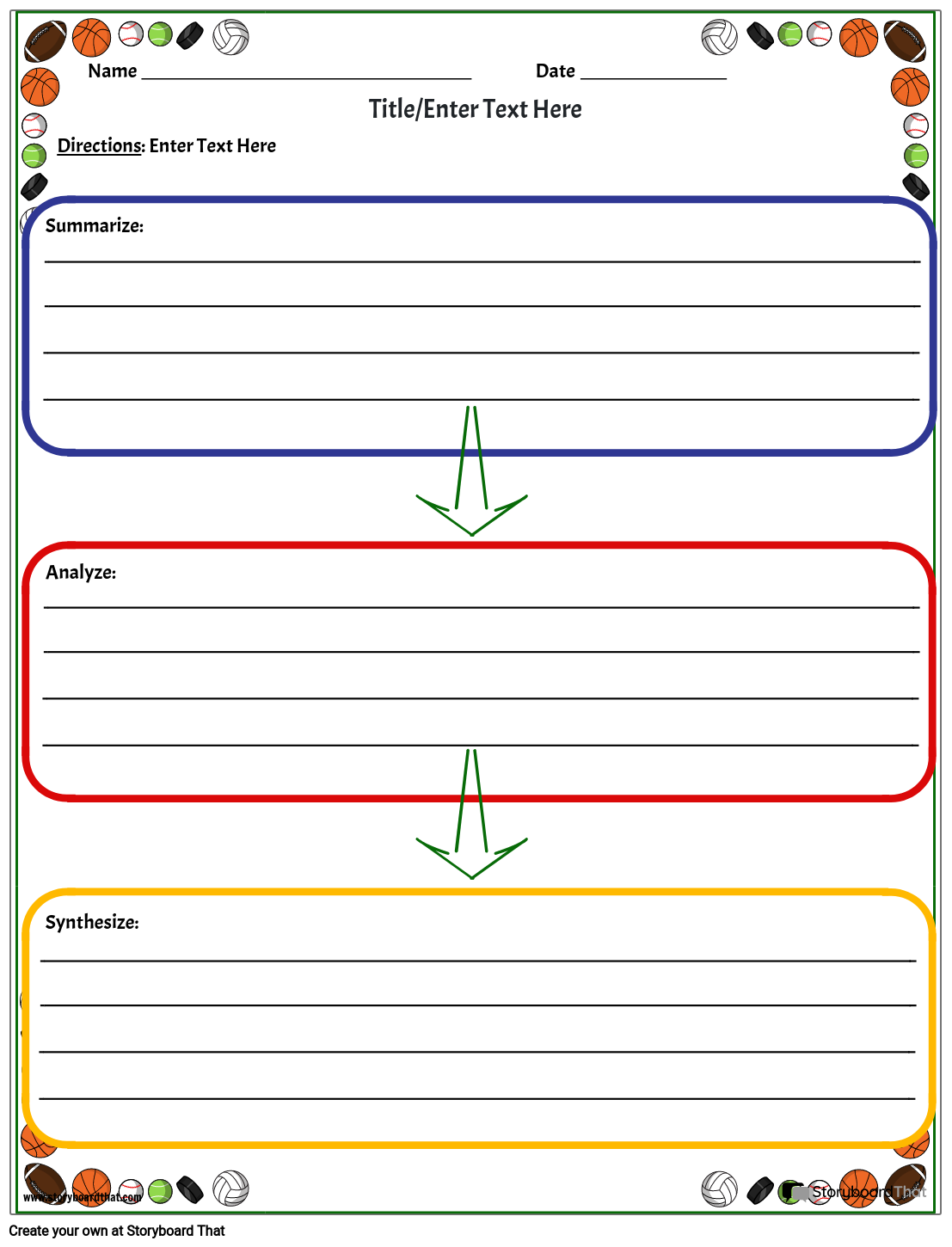
If you're assigning this to your students, copy the worksheet to your account and save. When creating an assignment, just select it as a template!
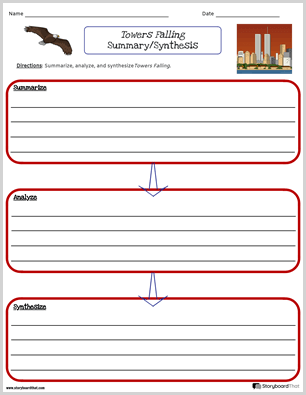
What is a Summary/Synthesis Worksheet?
In today's world, we are surrounded by an overwhelming amount of information. Whether it's news articles, academic journals, or social media posts, we are constantly bombarded with information that we need to digest and make sense of. This is where synthesizing information comes into play. So what is synthesizing information? It is the process of combining multiple sources of information to create a new understanding of a topic. It is an important skill that can help learners improve their reading comprehension and critical thinking abilities.
One effective way to teach students how to synthesize information is by using worksheets. Our worksheets ask students to paraphrase key information, analyze the importance of that information, and synthesize or draw a conclusion about that information. A summary deals with one text, whereas a synthesis is a response to multiple texts. These worksheets help differentiate between the two and learn how to apply each technique effectively. Summary analysis and information synthesizing worksheets are designed to help students identify the main ideas of a text and condense them into a brief summary. Synthesis worksheets, on the other hand, require students to analyze multiple sources of information and synthesize them into a new, cohesive understanding of the topic.
Why are They Important and How are They Best Used?
A summary synthesis draws on more than one source of information in order to analyze the information and reach a conclusion. These assignments can be used to craft literature reviews, articles, or source evaluations. They can also be used in synthesis papers where writers must write on one topic while drawing from a wide range of sources.
For example, let's say your class reads three different articles on the benefits of exercise. A summary worksheet might ask them to identify the main benefits mentioned in each article and write a brief summary of each. A synthesis worksheet, on the other hand, might ask them to analyze the information from all three articles and synthesize a new understanding of the benefits of exercise, taking into account all three perspectives.
Summary vs. Synthesis
These are two important skills that students need to develop in order to understand and analyze information effectively. The difference between synthesis and summary is more nuanced than its main similarity which is that both involve condensing information into a more concise form. There are important differences between the two.
For example, imagine you are reading an article about climate change. A summary of the article might say:
"This article discusses the effects of climate change on weather patterns and sea levels. It argues that human activity is largely responsible for these changes and that urgent action is needed to mitigate the impacts of climate change on the environment and society."
This captures the key points of the article in a concise and straightforward manner.
Synthesis, on the other hand, involves taking multiple pieces of information and combining them into a new and original whole. It is a way of making connections between different sources of information and creating something new and unique from them. Synthesis can be found in a wide range of contexts, from academic research papers to creative writing, and is often used as a way of developing new insights or ideas. The examples below illustrate the differences.
Summary vs Synthesis Example
For example, imagine you are researching the impact of social media on mental health. You might read multiple studies that explore different aspects of this topic, such as the effects of social media on self-esteem, the relationship between social media use and depression, and the impact of social media on sleep patterns. Through synthesis, you might combine these different pieces of information to develop a new understanding of the topic, such as with the example below:
"Social media has a complex relationship with mental health, with studies showing that it can impact self-esteem, contribute to depression, and disrupt sleep patterns. While there is no clear consensus on the overall impact of social media on mental health, it is clear that it is a topic that requires further research and attention."
This synthesis combines multiple pieces of information to create a new and nuanced understanding of the topic, incorporating insights from multiple sources.
They are both important skills that students need to develop in order to effectively understand and analyze information. Both skills are valuable in a wide range of contexts, from academic research to everyday life, and can help students to better understand complex ideas and concepts.
Creating a Successful Lesson Plan
To create a successful lesson plan, it is important to start with clear learning objectives. These objectives should outline what students will be able to do by the end of the lesson, such as, "Students will be able to differentiate between summary and synthesis and apply each technique effectively."
Once the learning objectives are established, you can begin to plan the activities that will help students achieve those objectives. One effective way to teach synthesis is by using graphic organizers that help students organize their thoughts and analyze multiple sources of information. For example, a Venn diagram can be used to compare and contrast information from two different sources. A T-chart can be used to compare and contrast two different perspectives on a topic.
It is also important to include a variety of primary sources in the lesson plan. Primary sources, such as original documents or firsthand accounts, can provide students with a deeper understanding of a topic and allow them to form their own opinions.
Finally, it is important to provide kids with analysis worksheets that help them apply the techniques they have learned. These worksheets should ask students to analyze a text and identify the main ideas, supporting details, and any biases or assumptions present in the text.
There are many free summarizing worksheets and synthesizing information worksheets available online that can help teachers create effective, detailed lesson plans. These worksheets can be tailored to fit the needs of each class and can be used to reinforce the skills that have been taught in class.
In conclusion, synthesizing information is an important skill that can help kids become better readers and critical thinkers. By using worksheets, graphic organizers, primary sources, and analysis worksheets, teachers can create effective lesson plans that teach their class how to synthesize information from multiple sources and create a new understanding of a topic.
Planning a Worksheet
- Identify the Text or Topic: Choose a text or topic that you want your class to summarize or synthesize.
- Determine the Purpose: Decide on the purpose of the worksheet. Is it to check for comprehension or to encourage critical thinking and analysis?
- Identify the Main Ideas: Identify the main ideas or themes of the text or topic. This will help you create prompts or questions for the worksheet.
- Determine the Format: Decide on the format. Will it be a written response or a visual representation, such as a storyboard or mind map?
- Create Prompts or Questions: Create prompts or questions that guide students in summarizing or synthesizing the information. These should be clear and concise, and encourage critical thinking and analysis.
- Provide Scaffolding: Provide scaffolding for students who may need additional support. This can include the use of synthesis graphic organizers, sentence starters, or sentence frames.
- Revise and Edit: Review and revise as necessary. Ensure that the prompts or questions are clear and that the format is appropriate for the task.
- Use as a Teaching Tool: Use the worksheet as a teaching tool to reinforce important concepts and skills. Provide feedback to students and use their responses to guide future instruction.
By following these steps, you can create effective worksheets that engage and challenge your students while supporting their learning.
How to Make A Summary and Synthesis Worksheet
Choose one of the premade templates.
We have lots of templates to choose from. Take a look at our example for inspiration!
Click on "Copy Template"
Once you do this, you will be directed to the storyboard creator.
Give Your Worksheet a Name!
Be sure to call it something related to the topic so that you can easily find it in the future.
Edit Your Worksheet
This is where you will include directions, specific questions and images, and make any aesthetic changes that you would like. The options are endless!
Click "Save and Exit"
When you are finished with your worksheet, click this button in the lower right hand corner to exit your storyboard.
From here you can print, download as a PDF, attach it to an assignment and use it digitally, and more!
Even More Storyboard That Resources and Free Printables
- Critical Analysis Essay Outlines
- Thesis Statement Worksheets
- Point of View Worksheets
- Character Analysis Worksheet
- First Day of School Templates
- Checklist Templates
Happy Creating!
Frequently Asked Questions About Summary and Synthesis Worksheets
What is synthesizing information and what is the difference between synthesis and summary.
Synthesizing information involves combining multiple sources to create a new, integrated understanding. It goes beyond summarizing by analyzing each source and connecting the dots to create something new. The key difference between the two is that synthesis creates something new by combining information from multiple sources, while summary condenses information from a single source into a brief statement.
How can summary and synthesis worksheets be used in the classroom?
These worksheets are valuable tools for promoting student learning. They can improve reading comprehension, develop critical thinking skills, reinforce learning objectives, and assess student understanding. By identifying the main ideas of a text and synthesizing information from multiple sources, students can create a new understanding of a topic and support their arguments with evidence. Worksheets can be adapted to meet the needs of different students and are effective for promoting learning across various learning styles.
What are the benefits of using storyboards to teach summary and synthesis?
Storyboards offer several benefits for teaching. They provide visual representations that aid in understanding and remembering key concepts, engage students creatively, allow synthesis from multiple sources, develop critical thinking skills, and promote collaboration among students. Storyboards offer an exciting and engaging classroom environment that can support student learning and be tailored to different learning preferences.
In which academic subjects can the use of summary and synthesis worksheets and storyboards be beneficial?
These worksheets and storyboards can be used in various subjects to improve students' critical thinking skills and understanding of complex concepts. Examples include ELA, where students can summarize novels and articles, social studies where students can synthesize information from primary and secondary sources, science where students can visualize data to identify patterns, and math where students can create visual representations of word problems.
Pricing for Schools & Districts
Limited Time
- 10 Teachers for One Year
- 2 Hours of Virtual PD
30 Day Money Back Guarantee • New Customers Only • Full Price After Introductory Offer • Access is for 1 Calendar Year

- Thousands of images
- Custom layouts, scenes, characters
- And so much more!!
Create a Storyboard
Limited Time. New Customers Only
Back to school special!
Purchase orders must be received by 9/6/24.
30 Day Money Back Guarantee. New Customers Only. Full Price After Introductory Offer. Access is for 1 Calendar Year
Generating a Quote
This is usually pretty quick :)
Quote Sent!
Email Sent to

COMMENTS
Writing a Synthesis Essay . 1. What is a synthesis? A synthesis is a written discussion incorporating support from several sources of differing views. This type of assignment requires that you examine a variety of sources and identify their relationship to your thesis. 2. Synthesis is used in: • Analysis papers to examine related theories.
The writing process for composing a good synthesis essay requires curiosity, research, and original thought to argue a certain point or explore an idea. Synthesis essay writing involves a great deal of intellectual work, but knowing how to compose a compelling written discussion of a topic can give you an edge in many fields, from the social sciences to engineering.
SIS ESSAY PEER REVIEW WORKSHEET For our peer editing session, you will be responsible for r. __. _____________ The Introduction 1. Go through the introduction and underline the hook statement (if used) and doub. nderline the thesis statement. 2. Review the thesis Does.
In a synthesis essay outline, note a claim and evidence for every paragraph. 4. Mention a Rebuttal. One paragraph of your synthesis essay should cover an opposing view that challenges your position. Outline it as follows: State an alternative point to your argument; provide evidence to back up that view. Provide your counterargument to that view.
All About These 15 Worksheets. This series of 15 worksheets offers a comprehensive and engaging resource designed to help students master the art of crafting well-structured and persuasive synthesis essays. These meticulously designed worksheets provide a step-by-step approach to guide students in analyzing multiple perspectives, synthesizing ...
Examples of synthesis writing are: An explanatory synthesis essay, in which the writer presents factual information to help the reader understand a subject. In an expository synthesis essay, the ...
Students who take the quiz and worksheet will be practicing the skills below: Reading comprehension - read and pull the most important information from the related lesson on writing synthesis ...
Title: Microsoft Word - Synthesis Essay Instructions and Worksheets.doc Author: Carly Mounts Created Date: 3/25/2019 11:29:09 PM
Synthesis Essay Outline I. Introduction = Thesis (topic and position are clearly stated with supporting arguments, 1 sentence only) ... Microsoft Word - Synthesis Essay Instructions and Worksheets.doc Author: Carly Mounts Created Date: 3/25/2019 11:30:27 PM ...
C. Thesis must clearly state your position and 2 supportive arguments that show why you have that position. II. Paragraph #2: Body Paragraph #1- first argument that supports your position presented in the thesis: Topic sentence explaining your first argument/claim. Transition: Use transitional phrases to introduce your next argument/claim. (ex.
3. Draft a thesis. The thesis statement is the conclusion you make after reading various texts. This is often an answer to the question the instructor poses in an assignment. For example, with argumentative synthesis essays, you might have to take a stance on an issue like where we should spend tax dollars.
The two synthesis essay questions below are examples of the question type that has been one of the three free-response questions on the AP English Language and Composition Exam as of the May 2007 exam. The synthesis question asks students to synthesize information from a variety of sources to inform their own discussion of a topic. Students are given a 15-minute reading period to accommodate ...
First, read the Introduction to Topic in the Synthesis Essay Assessment with Sourcespacket to determine the topic and task. Then, carefully read through each source in the packet and complete the Annotation Worksheet for each source. Next, use your annotations to complete the Brainstorming Worksheetto determine the position you want to argue ...
complete the Synthesis Essay Outline to organize your thoughts and identify sources that could provide evidence for each supporting idea. Next, you should be able to draft your essay by completing the Synthesis Essay Rough Draft Worksheet. Finally, after editing your draft, revise your essay and submit the final draft electronically as a PDF.
The synthesis matrix is a chart that allows a researcher to sort and categorize the different arguments presented on an issue. Across the top of the chart are the spaces to record sources, and along the side of the chart are the spaces to record the main points of argument on the topic at hand. As you examine your first source, you will work ...
HANDOUT 2: PEER REVIEW WORKSHEET. Switch papers with your partner. You will take turns reading each other's papers out loud; this is the procedure that. s followed in the writing center. Your roles as reader/consultant and listene. /consultee are equally important. Therefore, here are some guidelines to fol.
It also doesn't analyze the sources or consider gaps in existing research. Example: Effective synthesis. Research on the barriers to second language acquisition has primarily focused on age-related difficulties. Building on Lenneberg's (1967) theory of a critical period of language acquisition, Johnson and Newport (1988) tested Lenneberg ...
Synthesis Essay Worksheet Critical Reading of Texts/Evaluating Sources TOPIC: Death Penalty _____ Directions: For each of the sources included in the packet, consider the following elements. Write your answers on separate paper. Source Title/Letter: G; Nick Anderson ...
Read 'Em and Weave Synthesis Essay Unit (Angie Kratzer) $12.00 4.9* -- Includes 10 lessons. Synthesis Essay Workbook (Jenna Copper) $5.00 4.9* -- Includes original pompt used to teach process. Synthesis Essay Unit Student Choice (The Daring English Teacher) $15.99 4.9* -- Four Student-related Topics for Mini-Synthesis.
Sports Balls Themed Summary & Synthesis Worksheet. Copy Template. Pastel Boxes Based Summary & Synthesis Template. Copy Template. Summary & Synthesis Template with Yellow Theme. Copy Template. Green Futuristic Summary & Synthesis Worksheet. Copy Template. 3 Boxes Based Summary & Synthesis Template.
Synthesis Essay Worksheet Critical Reading of Texts/Evaluating Sources TOPIC: Death Penalty _____ Directions: For each of the sources included in the packet, consider the following elements. Write your answers on separate paper. Source Title/Letter: G; Nick Anderson ...